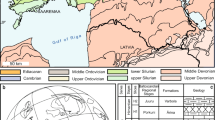Abstract
We report for the first time the presence of local populations of the starfish Odontaster penicillatus in the regions of Atacama and Antofagasta, Chile. This finding indicates an extension of the distribution limit of 500 km with respect to the last observation made in 2007 in Isla Grande de Atacama. A total of 121 specimens of O. penicillatus were recorded at depths of between 8 m and 24 m. They were associated with rocky substrate and with different species of barnacles, sponges and bryozoans. The presence of O. penicillatus expands the knowledge of the benthic biodiversity of the region, and the development of studies on its ecological importance will be promoted.
Similar content being viewed by others
References
Arntz W E, Gutt J, Klages M. 1997. Antarctic marine biodiversity: an overview. In: Battaglia B, Valencia J, Walton D W H, eds. Antarctic Communities: Species, Structure and Survival. Cambridge: Cambridge University Press, 3–14
Benítez-Villalobos F, Díaz-Martínez J P, Tyler P A. 2007. Biología reproductiva del asteroideo de mar profundo Henricia abyssicola en el Atlántico NE. Ciencias Marinas (in Spanish), 33(1): 49–58, doi: https://doi.org/10.7773/cm.v33i1.329
Codoceo M, Andrade H. 1978. Asterozoos arquibentónicos de Chile central. Anales del Museo de Historia Natural (in Spanish), 11: 153–174
Dayton P K, Robilliard G A, Paine R T, et al. 1974. Biological accommodation in the benthic community at McMurdo Sound, Antarctica. Ecological Monographs, 44(1): 105–128, doi: https://doi.org/10.2307/1942321
Gaymer C F, Rojas U, Squeo F A, et al. 2008. AMCP-MU Isla Grande de Atacama: Flora y Fauna Marina y Terrestre. In: Saqueo F A, Arancio G, Gutiérrez J R, eds. Libro Rojo de la Flora Nativa y de los Sitios prioritarios para su Conservación: Región de Atacama (in Spanish). La Serena: Ediciones Universidad de La Serena, 12: 223–249
Gil D G, Zaisxo H E. 2008. Feeding ecology of the subantarctic sea star Anasterias minuta within tide pools in Patagonia, Argentina. Revista de Biologia Tropical, 56(S3): 311–328
Hermosillo-Núñez B B. 2020. Contribution of echinoderms to keystone species complexes and macroscopic properties in kelp forest ecosystems (northern Chile). Hydrobiologia, 847(3): 739–756, doi: https://doi.org/10.1007/s10750-019-04134-8
Janosik A M, Halanych K M. 2010. Unrecognized Antarctic biodiversity: a case study of the genus Odontaster (Odontasteridae; Asteroidea). Integrative and Comparative Biology, 50(6): 981–992, doi: https://doi.org/10.1093/icb/icq119
Janosik A M, Mahon A R, Halanych K M. 2011. Evolutionary history of Southern Ocean Odontaster sea star species (Odontasteridae; Asteroidea). Polar Biology, 34(4): 575–586, doi: https://doi.org/10.1007/s00300-010-0916-7
Kidawa J, Potocka M, Janecki T. 2010. The effects of temperature on the behaviour of the Antarctic sea star Odontaster validus. Polish Polar Research, 31(3): 273–284, doi: https://doi.org/10.2478/v10183-010-0003-3
Loh K S, Todd P A. 2011. Diet and feeding in the sea star Astropecten indicus (Döderlein, 1888). The Raffles Bulletin of Zoology, 59(2): 251–258
Martín A, Penchaszadeh P, Atienza D. 2001. Densidad y hábitos alimentarios de Oreaster reticulatus (Linnaeus, 1758) (Echinodermata, Asteroidea) en praderas de fanerógamas marinas de Venezuela. Boletín Instituto Español de Oceanografía (in Spanish), 17(1–2): 203–208
McClintock J B. 1994. Trophic biology of Antarctic shallow-water echinoderms. Marine Ecology Progress Series, 111: 191–202, doi: https://doi.org/10.3354/meps111191
Moran P J, De’ath G, Baker V J, et al. 1992. Pattern of outbreaks of crown-of thorns starfish (Acanthaster planci L.) along the Great Barrier Reef since 1966. Australian Journal of Marine and Freshwater Research, 43(3): 555–567, doi: https://doi.org/10.1071/MF9920555
Mutschke E, Mah C. 2009. Asteroidea-Estrellas de mar. In: Häussermann V, Försterra G, eds. Santiago: Nature in focus, 801–830
Mutschke E, Rios C. 2006. Distribución espacial y abundancia relativa de equinodermos en el estrecho de Magallanes, Chile. Ciencia y Tecnología del Mar (in Spanish), 29(1): 91–102
Pearse J S, Bosch I. 1986. Are the feeding larvae of the commonest antarctic asteroid really demersal?. Bulletin of Marine Science, 39(2): 477–484
Peck L S, Webb K E, Miller A, et al. 2008. Temperature limits to activity, feeding and metabolism in the Antarctic starfish Odontaster validus. Marine Ecology Progress Series, 358: 181–189, doi: https://doi.org/10.3354/meps07336
Thiel M, Macaya E C, Acuña E, et al. 2007. The humboldt current system of northern and central Chile: Oceanographic processes, ecological interactions and socioeconomic feedback. Oceanography and Marine Biology: An Annual Review, 45: 195–344, doi: https://doi.org/10.1201/9781420050943.ch6
Tyler P A, Billett D S M, Gage J D. 1990. Seasonal reproduction in the seastar Dytaster grandis from 4000 m in the north-east Atlantic Ocean. Journal of the Marine Biological Association of the United Kingdom, 70(1): 173–180, doi: https://doi.org/10.1017/S0025315400034299
Vasquez H A, Retamales P B, Rojas M C. 1980. Consideraciones biogeográficas y ecológicas de equinodermos arquibentónicos de Chile central (com excepción de Crinoidea). Boletim do Instituto Oceanografico, Sao Paulo (in Spanish), 29(2): 37–39
Waters J M, King T M, Fraser C I, et al. 2018. Rafting dispersal in a brooding southern sea star (Asteroidea: Anasterias). Invertebrate Systematics, 32(2): 253–258, doi: https://doi.org/10.1071/IS17037
Acknowledgements
Thanks to Carlos Alvarez and Cristian Godoy for their kindness in sharing photographs and videos of Odontaster penicillatus specimens.
Author information
Authors and Affiliations
Corresponding author
Rights and permissions
About this article
Cite this article
Campos, L., Berrios, F., Hermosillo-Núñez, B.B. et al. First record of Odontaster penicillatus populations (Philippi, 1870) (Echinodermata: Asteroidea) in the Atacama and Antofagasta regions, Chile (Southeast Pacific). Acta Oceanol. Sin. 41, 152–155 (2022). https://doi.org/10.1007/s13131-021-1957-1
Received:
Accepted:
Published:
Issue Date:
DOI: https://doi.org/10.1007/s13131-021-1957-1




